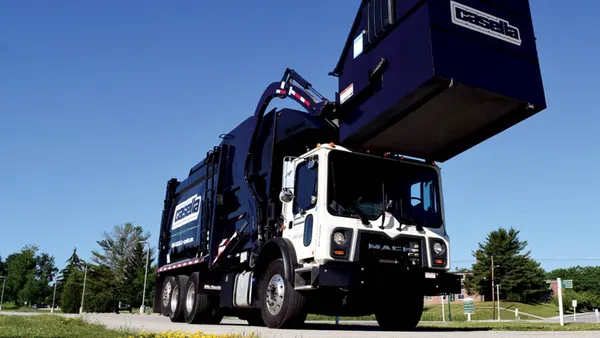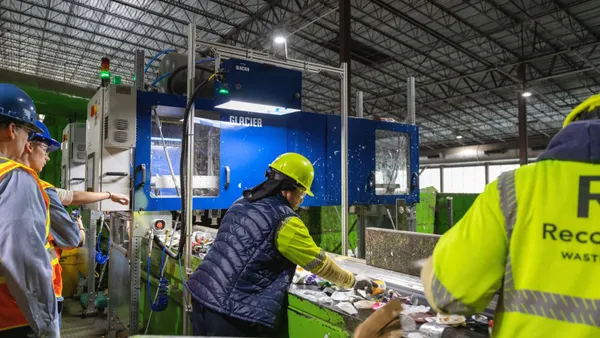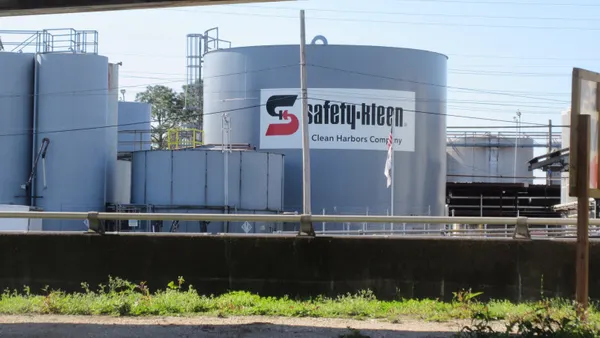NOTE: This story has been updated to use CalRecycle's preferred terminology of "recycling rate" rather than "diversion rate," as established by AB 341, and also include new comments from state organizations.
Dive Brief:
- A new report shows that California's statewide recycling rate decreased to 44% in 2016, the lowest since a goal of 75% recycling was set in 2011, at the same time as per capita waste generation rates increased for the fourth consecutive year. Overall, the California Department of Resources Recycling and Recovery (CalRecycle) estimates that 76.5 million tons of waste were generated in the state last year.
- CalRecycle reports that this continues a trend of no meaningful disposal rate decrease since 2009, with landfills remaining the top disposal destination. The state report links this consumption trend to increasing wages and said "disposal will also increase unless there are policy and programmatic changes that start to decouple economic growth from growth in disposal."
- Reaching the goal of 75% recycling by 2020 would mean cutting current disposal rates in half. When asked whether this new data meant that goal was no longer attainable, CalRecycle deferred by pointing to packaging and organics diversion as top priorities. "The goals we establish for better sustainability are important and so too are the benefits we see from the pursuit of those goals. CalRecycle remains confident the state’s progressive recycling and waste reduction efforts will provide long-term benefits to Californians, our environment, and our economy," said Lance Klug, a public information officer for CalRecycle, via email.
Dive Insight:
California's waste and recycling policies are often held up as a standard for others in the country to follow, and they are indeed ambitious. The state currently mandates a local diversion rate of 50% and requires that recycling and organics collection be offered in commercial and multi-unit buildings. In addition to the 75% recycling target, the state also has goals of 50% organic waste reduction by 2020 and 20% food recovery by 2025.
Yet as noted in the CalRecycle report, much of the state's recycling infrastructure was built around a flagging container redemption industry and is lacking incentives to expand capacity for critical streams such as organics. The state, not local jurisdictions, also bears responsibility for achieving most of these targets without many enforcement mechanisms at its disposal. Other headwinds include relatively low landfill tip fees, declining overseas commodity prices, a stagnation in development of new organics processing infrastructure and the closure of "several hundred" recycling centers in the state.
In a statement on the new report, Solid Waste Association of North America (SWANA) David Biderman pointed out that weight-based metrics don't give a full picture due to the trend in lighter weight packaging but said the recycling rate decline was concerning.
"Many recycling centers in California have closed over the past two years. As a result, the percentage of beverage containers recycled in CA has declined from 85% in 2013 to below 80% in 2016. Lower commodity prices and less demand overseas are factors as well. SWANA and its California members will continue to promote sustainable recycling and waste diversion programs, and work with all stakeholders to improve current practices," wrote Biderman via email.
Jenna Abbott, executive director of the California Resource Recycling Association (CRRA), also responded to the news.
"Because California has long been a leader in waste reduction and recycling, yesterday’s news is troubling. The California Resource Recycling Association and its members are focused on finding the path to achieving zero waste, and to get there, we need to work with all stakeholders to get to the root of the problem," wrote Abbott via email, mentioning CRRA's upcoming conference in San Diego as a chance for further discussion. "We are confident that, with the help of strong partners and the industry, we can and will find ways to reverse this uptick and pursue our goal of zero waste."
The state report cites multiple upcoming initiatives and changes that will help gather more data, but a greater focus on material-specific recycling strategies is seen as the main priority. Target areas include construction and demolition debris and lumber (20% of the waste stream), packaging (25%) and organics (40%). The agency pointed to $24 million in recent organics processing investment through California Climate Investment grants. This is the second year those state grants have been awarded to organics projects and demand is reportedly very high. To reach the state's organic reduction goals, an estimated 20 million tons of new capacity will be needed by 2025.
CalRecycle also continues to pursue potential packaging mandates, after responses to a voluntary request for solutions from manufacturers were seen as unsatisfactory, and will hold another meeting on the topic next month. In response to the new report, the California Product Stewardship Council (CPSC) pointed to extended producer responsibility requirements in Europe as a sign of what's possible in the state.
"Producers could work hand and hand with CalRecycle, local governments, waste haulers and retailers and CPSC to ensure that the products they sell have been source reduced where possible, are durable, repairable, reusable, and easily recyclable," wrote Heidi Sanborn, CPSC's executive director, via email. "We need to grow California jobs in recycling and remanufacturing to create markets and jobs – our people and our environment deserve nothing less."
While cities such as San Francisco and Los Angeles are often held up for their ambitious recycling programs, this latest report shows the complexity of driving significant progress statewide. Many of the main factors — enforcing mandates without significant penalties, expanding organics infrastructure, unstable commodity prices — aren't unique to the state. Though the pace at which California seeks to overcome them, and the lengths to which it may go around packaging, sets their efforts apart.












